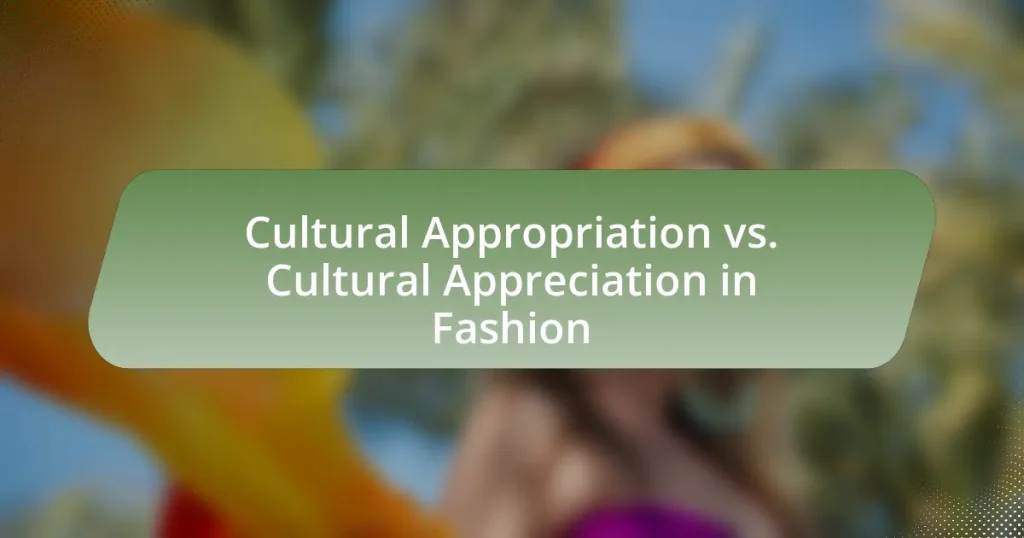Cultural appropriation and cultural appreciation in fashion are two distinct concepts that impact the representation and ethical responsibilities of designers. Cultural appropriation involves the unauthorized adoption of elements from one culture by another, often leading to exploitation and disrespect, while cultural appreciation emphasizes respectful acknowledgment and collaboration with cultural representatives. The article explores the historical roots of cultural appropriation, its negative effects on marginalized communities, and the evolution of cultural appreciation within the fashion industry. It also discusses strategies for brands and consumers to promote cultural sensitivity and highlights the role of technology and social media in shaping cultural narratives in fashion.

What is Cultural Appropriation vs. Cultural Appreciation in Fashion?
Cultural appropriation in fashion refers to the adoption of elements from one culture by members of another culture, often without permission or understanding, leading to exploitation and disrespect. In contrast, cultural appreciation involves a respectful acknowledgment and celebration of another culture, typically characterized by understanding, consent, and a desire to honor the cultural significance of the elements being used. For example, when designers incorporate traditional patterns or garments from indigenous cultures into their collections without crediting or compensating the source, it exemplifies cultural appropriation. Conversely, when a designer collaborates with artisans from that culture to create a collection that respects and highlights their heritage, it represents cultural appreciation. This distinction is crucial in the fashion industry, as it impacts cultural representation and the ethical responsibilities of designers.
How do cultural appropriation and cultural appreciation differ in the context of fashion?
Cultural appropriation and cultural appreciation differ in fashion primarily in intent and impact. Cultural appropriation involves the adoption of elements from one culture by members of another culture, often without understanding or respecting the original context, leading to exploitation and commodification. For example, when high-fashion brands use traditional Indigenous patterns without permission or acknowledgment, it exemplifies appropriation. In contrast, cultural appreciation involves a respectful acknowledgment and celebration of another culture, often including collaboration with cultural representatives and a focus on authenticity. An instance of appreciation is when designers work with artisans from a specific culture to create garments that honor their traditions. This distinction is crucial as appropriation can perpetuate stereotypes and harm marginalized communities, while appreciation fosters understanding and respect.
What are the historical roots of cultural appropriation in fashion?
Cultural appropriation in fashion has historical roots that trace back to colonialism and the globalization of trade. During the colonial era, Western powers often appropriated elements from colonized cultures, using traditional garments and motifs without understanding their significance. This practice continued into the 20th century, where designers like Paul Poiret and later, brands such as Gucci and Dior, incorporated ethnic styles into their collections, often stripping them of their original context. The commodification of these cultural elements has led to ongoing debates about ownership and respect, highlighting the power dynamics involved in fashion.
How has cultural appreciation evolved in the fashion industry?
Cultural appreciation in the fashion industry has evolved from a simplistic borrowing of styles to a more nuanced understanding and respect for the cultures being represented. Initially, fashion often appropriated elements from various cultures without acknowledgment or context, leading to criticism and calls for greater sensitivity. Over time, designers and brands have begun to engage in meaningful collaborations with cultural representatives, ensuring that the origins of styles are respected and celebrated. For instance, the rise of ethical fashion brands that prioritize cultural storytelling and authenticity reflects this shift. This evolution is evidenced by initiatives such as the Council of Fashion Designers of America (CFDA) promoting diversity and inclusion, which encourages designers to honor cultural heritage rather than exploit it.
Why is understanding the distinction between appropriation and appreciation important?
Understanding the distinction between appropriation and appreciation is important because it influences ethical interactions with diverse cultures. Appropriation often involves taking elements from a culture without permission or understanding, leading to exploitation and disrespect, while appreciation involves respectful engagement and acknowledgment of cultural significance. For instance, when fashion designers use traditional garments from marginalized cultures without credit or context, it exemplifies appropriation, which can perpetuate stereotypes and economic disparities. Conversely, when designers collaborate with cultural representatives and honor the origins of their inspirations, it reflects appreciation, fostering mutual respect and cultural exchange. This distinction is crucial for promoting inclusivity and sensitivity in the fashion industry.
What impact does cultural appropriation have on marginalized communities?
Cultural appropriation negatively impacts marginalized communities by perpetuating stereotypes and erasing their cultural significance. When dominant cultures adopt elements from marginalized cultures without understanding or respecting their origins, it can lead to commodification and trivialization of those cultures. For instance, the use of Native American headdresses in fashion often disregards their sacred meaning, reducing them to mere fashion statements. This not only disrespects the cultural heritage but also contributes to the ongoing marginalization and misrepresentation of these communities in broader society. Studies indicate that such appropriation can exacerbate feelings of alienation and disenfranchisement among marginalized groups, as their identities are co-opted without acknowledgment or compensation.
How can cultural appreciation foster inclusivity in fashion?
Cultural appreciation fosters inclusivity in fashion by promoting understanding and respect for diverse cultural expressions. When designers and brands engage with cultural elements authentically, they create space for marginalized voices and traditions, allowing for a richer, more varied fashion landscape. For instance, collaborations with artisans from different cultures can lead to innovative designs that celebrate heritage while providing economic opportunities for those communities. This approach not only enhances creativity but also encourages consumers to embrace and respect cultural diversity, as seen in successful initiatives like the collaboration between luxury brands and indigenous artists, which highlights traditional craftsmanship and storytelling.

What are the key examples of cultural appropriation in fashion?
Key examples of cultural appropriation in fashion include the use of Native American headdresses by non-Indigenous individuals, which commodifies sacred symbols, and the adoption of traditional African hairstyles, such as braids, by predominantly white fashion models, often without acknowledgment of their cultural significance. Additionally, the appropriation of Japanese kimonos in Western fashion shows, where the garment is stripped of its cultural context, exemplifies this issue. These instances highlight a pattern where elements of marginalized cultures are used for aesthetic purposes without respect for their origins or meanings.
What are some notable cases of cultural appropriation in recent fashion trends?
Notable cases of cultural appropriation in recent fashion trends include the use of Native American headdresses by various fashion brands and celebrities, which has sparked significant backlash for disrespecting Indigenous cultures. Additionally, the appropriation of traditional African prints and garments by Western designers, often without acknowledgment or compensation, has raised concerns about exploitation. Another example is the use of the kimono in Western fashion, particularly during events like music festivals, which has been criticized for trivializing Japanese culture. These instances highlight the ongoing debate surrounding the boundaries between cultural appreciation and appropriation in the fashion industry.
How did the fashion industry respond to these instances?
The fashion industry responded to instances of cultural appropriation by increasing awareness and implementing changes to promote cultural appreciation. Major brands began to engage in dialogues with cultural representatives and communities to ensure respectful representation. For example, in 2017, brands like Gucci and Marc Jacobs faced backlash for using traditional cultural elements without proper acknowledgment, leading to public apologies and commitments to collaborate with diverse designers. Additionally, initiatives such as the “Fashion for All” movement emerged, advocating for inclusivity and sensitivity towards cultural heritage in fashion design.
What lessons can be learned from these examples?
Lessons learned from examples of cultural appropriation versus cultural appreciation in fashion include the importance of understanding cultural context and the need for respectful engagement with diverse cultures. Recognizing that cultural appropriation often involves power imbalances and exploitation highlights the necessity for designers to seek permission and collaborate with cultural representatives. For instance, the backlash against certain fashion brands for using traditional motifs without acknowledgment illustrates the potential harm of appropriation. Conversely, successful examples of cultural appreciation, such as collaborations with indigenous artists, demonstrate how fashion can celebrate and honor cultural heritage while fostering mutual respect and understanding. These lessons emphasize the significance of ethical practices in the fashion industry.
What are the consequences of cultural appropriation in the fashion industry?
Cultural appropriation in the fashion industry leads to significant consequences, including the commodification of marginalized cultures, the erasure of cultural significance, and economic disparities. When designers adopt elements from cultures without understanding or respecting their origins, they often strip these elements of their meaning, reducing rich traditions to mere trends. For instance, the use of Native American headdresses in fashion shows has sparked outrage, as these items hold deep spiritual significance and are not mere accessories. Additionally, the fashion industry often profits from these appropriated designs while the original cultures do not receive any economic benefit, exacerbating existing inequalities. This dynamic can perpetuate stereotypes and reinforce power imbalances, as seen in cases where Black hairstyles are deemed unprofessional in workplaces but are celebrated in fashion contexts. Thus, cultural appropriation not only disrespects the source cultures but also contributes to broader societal issues of inequality and representation.
How does cultural appropriation affect brand reputation?
Cultural appropriation negatively affects brand reputation by leading to public backlash and loss of consumer trust. When brands adopt elements from marginalized cultures without proper understanding or respect, they risk being perceived as exploitative, which can result in social media outrage and calls for boycotts. For instance, in 2017, a major fashion brand faced significant criticism for using traditional Native American designs in a collection without permission, leading to a decline in sales and a tarnished image. This illustrates that brands must navigate cultural sensitivity carefully to maintain a positive reputation and consumer loyalty.
What legal implications can arise from cultural appropriation in fashion?
Cultural appropriation in fashion can lead to legal implications such as trademark infringement, copyright violations, and potential lawsuits for misrepresentation. When a designer uses elements from a culture without permission, they may infringe on trademarks held by individuals or communities associated with that culture. For instance, the use of traditional patterns or symbols can violate intellectual property rights if those elements are protected. Additionally, if a fashion brand misrepresents the cultural significance of an item, it may face legal action for false advertising or deceptive practices. Legal cases, such as the 2018 lawsuit against a major fashion brand for using indigenous designs without consent, illustrate the risks involved. These legal challenges highlight the importance of respecting cultural heritage and obtaining proper permissions when incorporating cultural elements into fashion.

How can fashion brands practice cultural appreciation responsibly?
Fashion brands can practice cultural appreciation responsibly by engaging in authentic collaboration with cultural communities. This involves seeking input and guidance from individuals who belong to the culture being represented, ensuring that their perspectives and traditions are respected and accurately portrayed. For example, brands can partner with artisans from specific cultures to create products that reflect genuine cultural significance, rather than appropriating symbols or styles without context. This approach not only honors the cultural heritage but also supports local economies and promotes sustainable practices. Research indicates that brands that engage in such collaborations can enhance their brand reputation and consumer trust, as seen in case studies of successful partnerships in the fashion industry.
What strategies can brands implement to ensure cultural appreciation?
Brands can implement strategies such as collaborating with cultural representatives, conducting thorough research, and prioritizing ethical sourcing to ensure cultural appreciation. Collaborating with cultural representatives allows brands to gain authentic insights and perspectives, ensuring that their representations are respectful and accurate. Conducting thorough research helps brands understand the cultural significance of the elements they wish to incorporate, preventing misrepresentation. Prioritizing ethical sourcing ensures that the communities from which cultural elements are drawn are fairly compensated and acknowledged, fostering a sense of respect and appreciation. These strategies collectively promote a genuine appreciation of culture rather than appropriation.
How can collaboration with cultural representatives enhance appreciation?
Collaboration with cultural representatives enhances appreciation by providing authentic insights and perspectives that deepen understanding of cultural significance. When fashion designers work alongside cultural representatives, they gain access to the historical context, traditional practices, and values associated with specific cultural elements. This collaboration fosters respect and recognition of the culture, as evidenced by initiatives like the partnership between the fashion brand Dior and Indigenous artists, which not only showcased traditional designs but also educated audiences about their cultural heritage. Such partnerships promote a more informed and respectful engagement with cultural symbols, ultimately leading to greater appreciation and avoidance of appropriation.
What role does education play in promoting cultural sensitivity in fashion?
Education plays a crucial role in promoting cultural sensitivity in fashion by providing knowledge about diverse cultural practices and histories. Through educational programs, fashion students and professionals learn to recognize and respect the origins of cultural symbols and garments, which helps prevent cultural appropriation. For instance, courses that include case studies on the impact of cultural misrepresentation in fashion highlight the importance of ethical design practices. Research indicates that fashion education that incorporates cultural studies fosters a more inclusive industry, as evidenced by initiatives in institutions like the Fashion Institute of Technology, which emphasize cultural awareness in their curriculum.
What are the best practices for consumers to support cultural appreciation in fashion?
Consumers can support cultural appreciation in fashion by prioritizing ethical brands that collaborate with artisans from diverse cultures. This practice ensures that the original creators receive fair compensation and recognition for their work. For instance, brands like Oiselle and Brother Vellies actively engage with local craftspeople, promoting cultural heritage while providing economic opportunities. Additionally, consumers should educate themselves about the cultural significance of the garments they purchase, fostering a deeper understanding and respect for the traditions behind them. Engaging in conversations about cultural representation in fashion also helps raise awareness and encourages brands to adopt more inclusive practices.
How can consumers identify and support brands that practice cultural appreciation?
Consumers can identify and support brands that practice cultural appreciation by researching the brand’s history, values, and collaborations with cultural communities. Brands that genuinely appreciate culture often engage in partnerships with cultural representatives, showcase authentic storytelling, and contribute to the communities they draw inspiration from. For instance, brands like Patagonia and Nike have been recognized for their efforts in promoting cultural narratives and supporting local artisans. Additionally, consumers can look for transparency in sourcing materials and labor practices, as ethical brands typically disclose their supply chains and community involvement. This approach not only fosters cultural respect but also encourages sustainable practices within the fashion industry.
What actions can individuals take to promote cultural sensitivity in their fashion choices?
Individuals can promote cultural sensitivity in their fashion choices by researching and understanding the cultural significance of garments and accessories before wearing them. This involves learning about the history, symbolism, and traditional uses of specific items, which helps to avoid misrepresentation and disrespect. For example, wearing a Native American headdress, which holds deep spiritual meaning, without understanding its significance can be seen as cultural appropriation. Engaging with and supporting designers from the culture being represented also fosters appreciation and respect, as it acknowledges the original creators and their contributions. Additionally, individuals can choose to wear fashion items that are inspired by cultures in a way that honors their origins, rather than appropriating them.
What are the future trends in cultural appreciation within the fashion industry?
Future trends in cultural appreciation within the fashion industry include increased collaboration with diverse cultural communities and a focus on authenticity in representation. Brands are increasingly recognizing the importance of engaging with cultural experts and artisans to ensure that their designs reflect genuine cultural narratives rather than stereotypes. For instance, the rise of sustainable fashion has led to a greater emphasis on ethical sourcing and the celebration of traditional craftsmanship, as seen in collections that highlight indigenous techniques and materials. This shift is supported by consumer demand for transparency and ethical practices, with a 2021 McKinsey report indicating that 67% of consumers consider sustainability when making fashion purchases.
How might technology influence cultural appreciation in fashion?
Technology influences cultural appreciation in fashion by enabling greater access to diverse cultural expressions and facilitating cross-cultural exchanges. Digital platforms, such as social media and e-commerce websites, allow designers and consumers to share and discover fashion from various cultures, promoting understanding and appreciation of different styles. For instance, the rise of platforms like Instagram has led to increased visibility for traditional garments and artisans, fostering a global dialogue about cultural significance. Additionally, advancements in virtual reality and augmented reality can provide immersive experiences that educate users about the history and meaning behind specific cultural attire, enhancing appreciation. This accessibility and engagement can help mitigate cultural appropriation by encouraging respectful and informed interactions with cultural elements in fashion.
What role will social media play in shaping cultural narratives in fashion?
Social media will play a pivotal role in shaping cultural narratives in fashion by providing a platform for diverse voices and perspectives. This democratization of content allows individuals from various cultural backgrounds to share their stories, challenge stereotypes, and promote appreciation over appropriation. For instance, campaigns like #BlackLivesMatter have influenced fashion brands to reconsider their cultural representations and engage in more inclusive practices. Additionally, social media analytics show that user-generated content significantly impacts consumer behavior, with 79% of consumers saying user-generated content highly impacts their purchasing decisions. This shift towards valuing authentic cultural narratives fosters a more nuanced understanding of fashion’s relationship with culture, ultimately driving brands to be more socially responsible.




